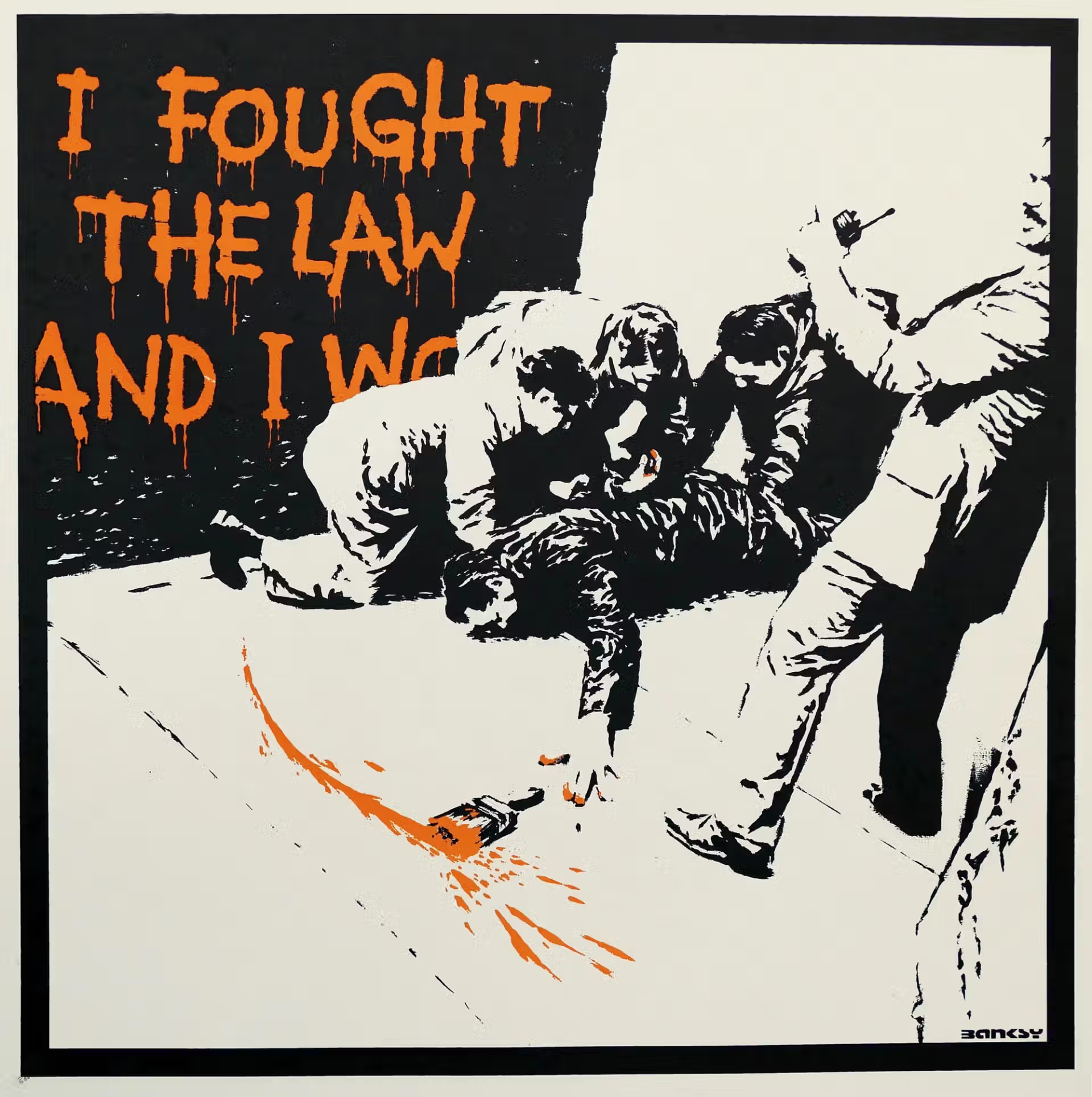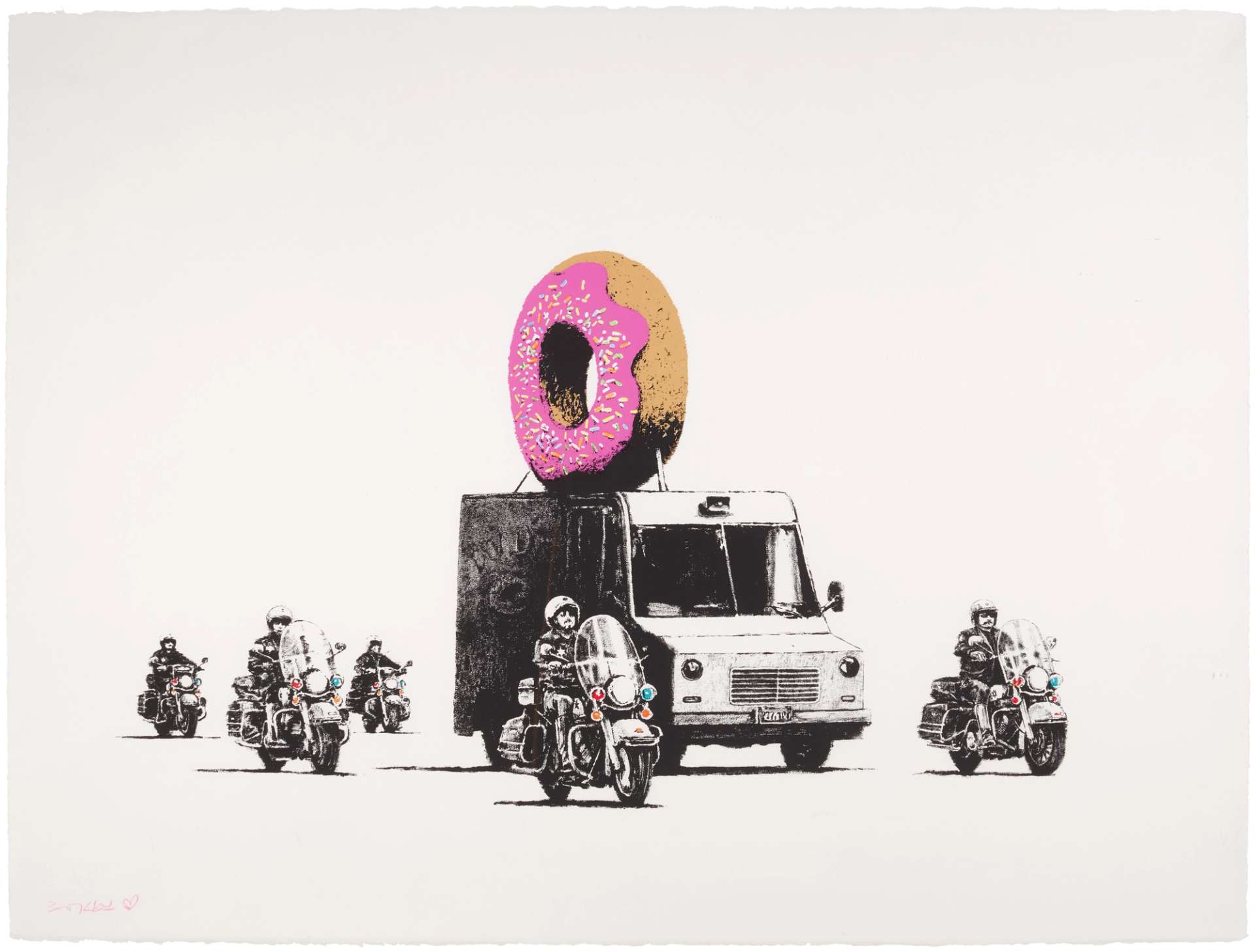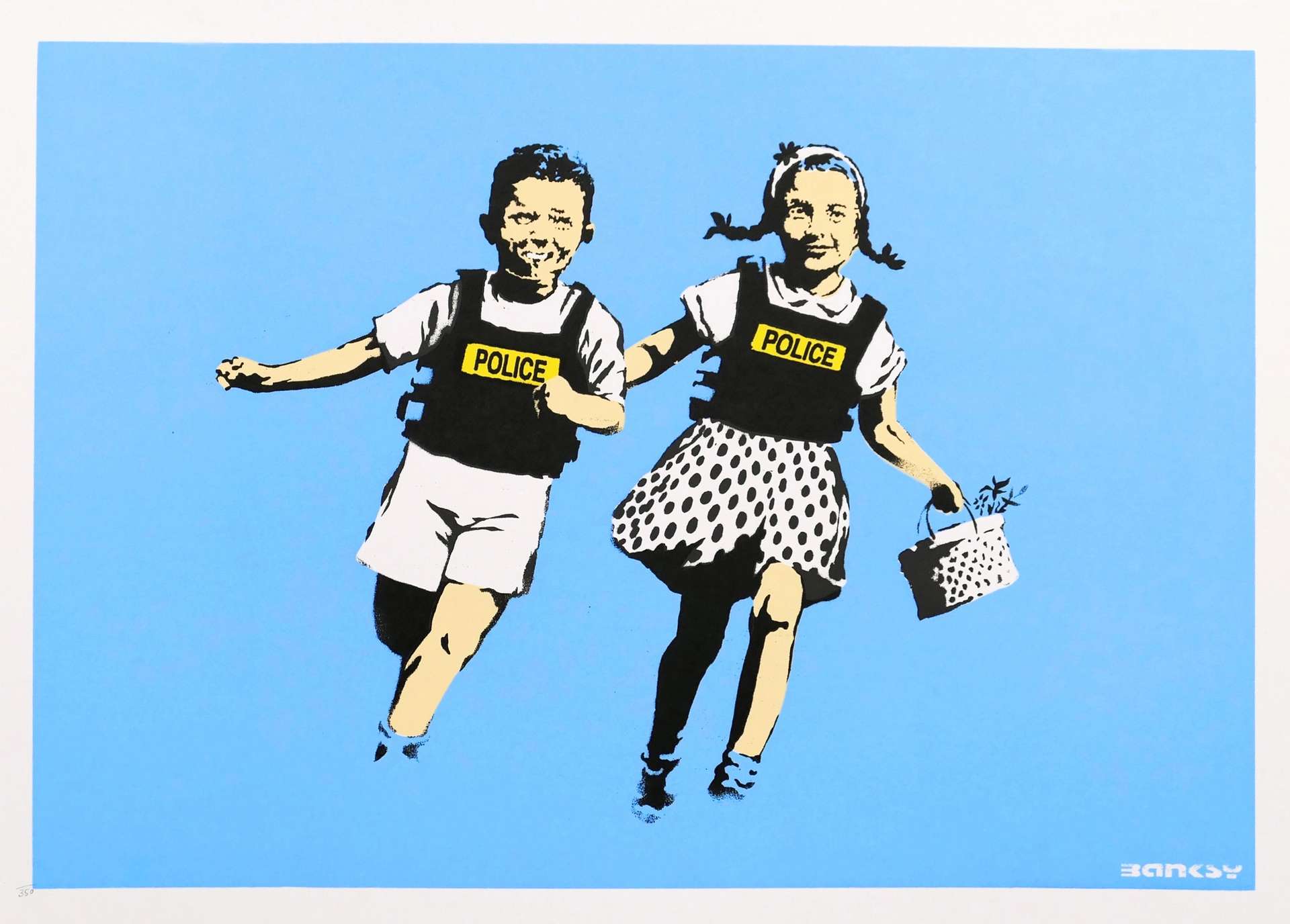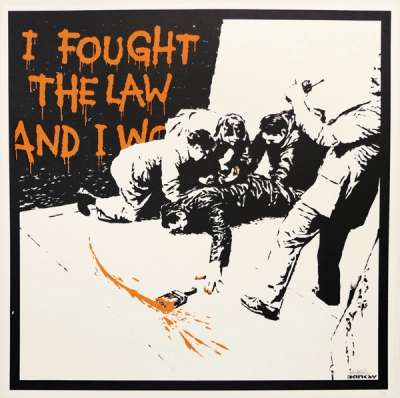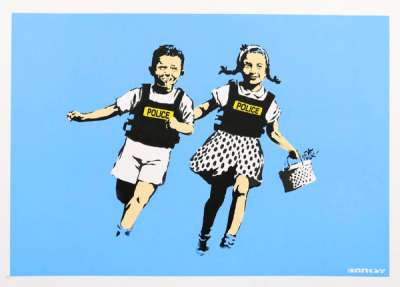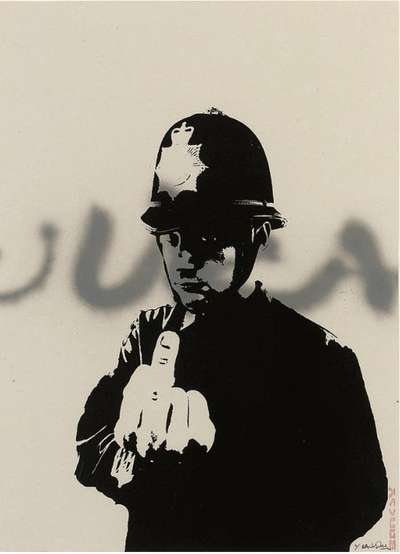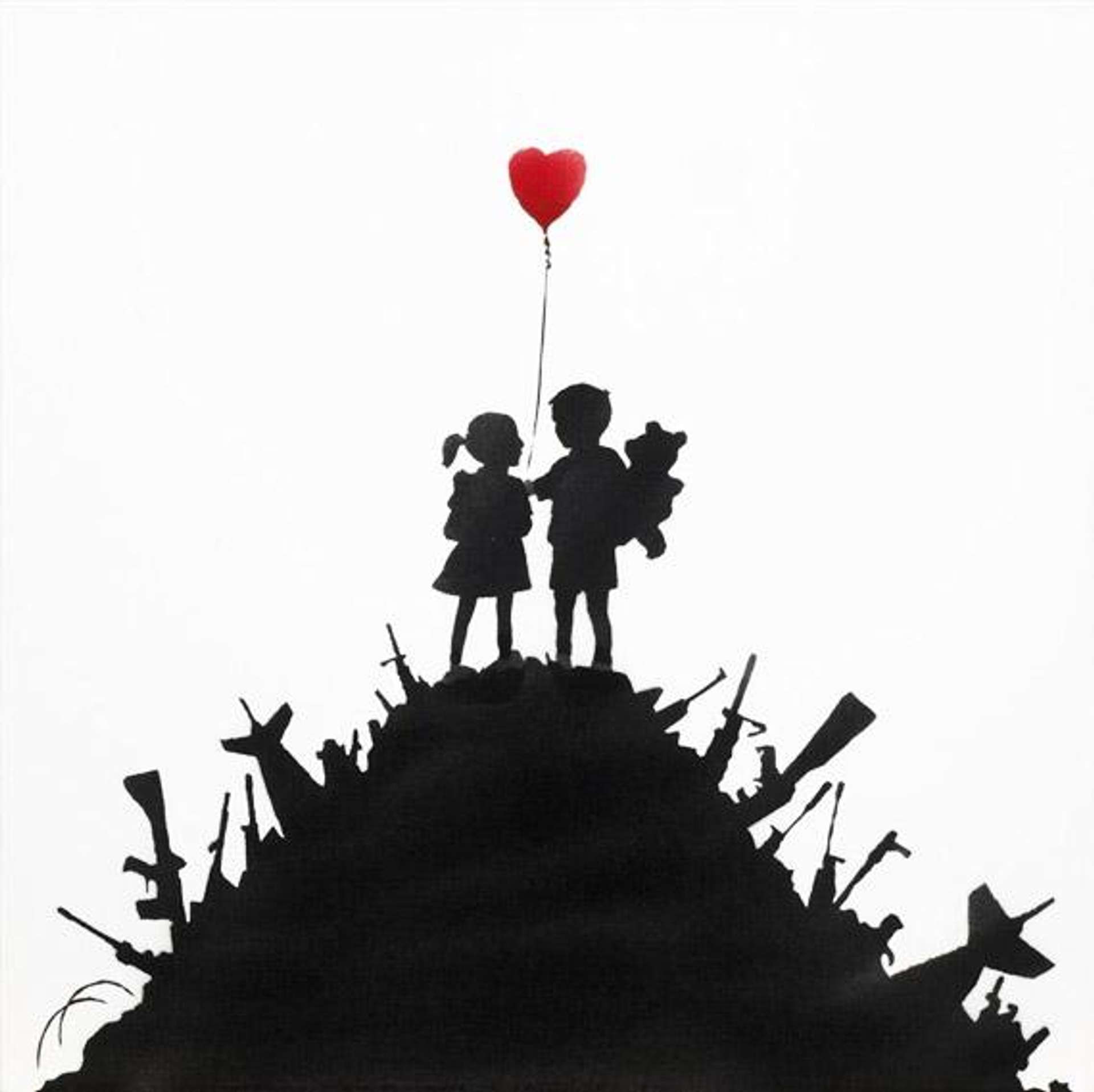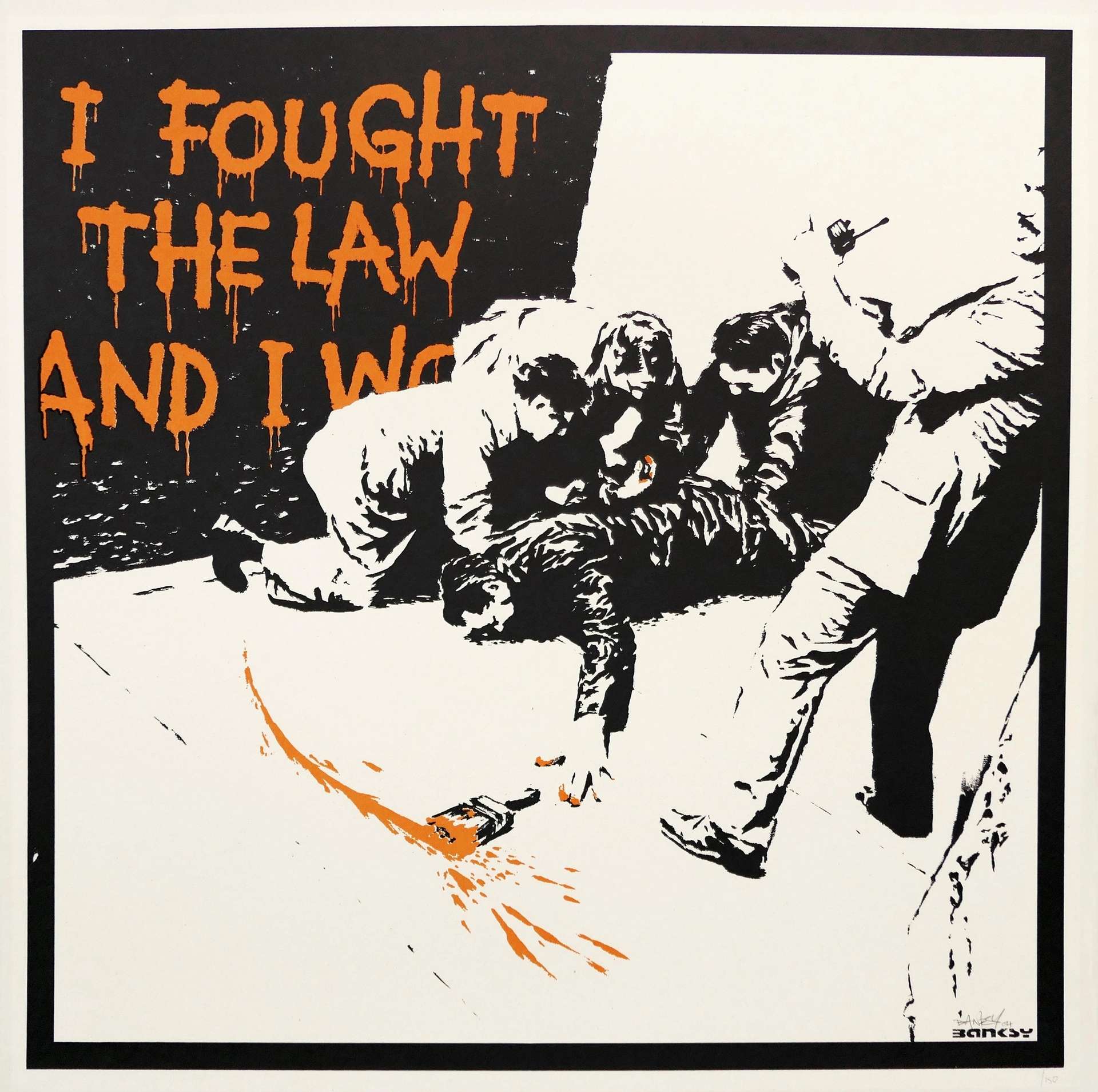 I Fought The Law © Banksy 2004
I Fought The Law © Banksy 2004Well known for his anti-establishment artworks, it is no surprise that one of Banksy’s most common subjects is the character of the police officer. Whether they are being ridiculed, impersonated or disparaged, these figures can be seen throughout the artist’s oeuvre in murals and prints alike.
As a graffiti artist the very nature of Banksy’s earliest works were criminal, and from the start he was forced to remain anonymous. These days it’s out of choice, but Banksy’s entire oeuvre is connected to law enforcement. Through the illegality of his art he is in constant tension with the forces of authority and his distinct stencilled style even came about as a way of making his mark quickly to avoid arrest. His long disdain for law enforcement can be seen in his first ever large-scale mural in Bristol, The Mild Mild West from 1997, which shows a teddy bear throwing a Molotov cocktail at three riot police.
However, Banksy’s complex and often witty relationship to the police is perhaps best encapsulated by the words that can be found on the back of his 2005 book, Wall And Piece: ‘“There’s no way you’re going to get a quote from us to use on your book cover” – Metropolitan Police spokesperson’.
As the artist’s work has matured these attacks on the state and its protectors show no signs of slowing down. In June of 2020, when the US and UK erupted with protests over the murder of George Floyd at the hands of the Minneapolis police force, Banksy posted a new artwork to Instagram in support of the Black Lives Matter movement that showed a memorial candle setting the American flag alight, accompanied by a short but powerful statement that said, among other things, ‘people of colour are being failed by the system’.
Why does Banksy target the police?
While we are taught that the police are there to ‘protect and serve’ the citizens of a country, for anti-establishment artists such as Banksy it often seems like they are nothing but puppets of an authoritarian ‘nanny state’. Commenting on this position Banksy has said, “My main problem with cops is that they do what they’re told. They say ‘Sorry mate, I’m just doing my job’ all the fucking time. And every time someone says ‘if it was down to me it would be ok, but I’m following orders’ a little bit inside of you dies. If you say it as often as cops do, then there isn’t much left.” In a similar vein he has also said that “The greatest crimes in the world are not committed by people breaking the rules but by people following the rules. It’s people who follow orders that drop bombs and massacre villages.”
In response to this attitude Banksy creates works of art that question this implacable authority. In pieces such as Rude Copper an officer wearing an old fashioned custodian helmet can be seen raising his middle finger to the viewer. Although still worn today, this headwear is largely considered to be the signature of the old ‘Bobby on the Beat’, a local, friendly neighbourhood copper, who is a far cry from the figure in the image.
How does Banksy use the image of the policeman in his work?
For Banksy the image of a police officer is often a way of showing the plight of the underdog, the powerless and the dispossessed. In works such as I Fought The Law, the artist pays homage to the famous song by The Clash to condemn police brutality and perhaps even inspire fellow citizens to speak out through the medium of graffiti. With its punk references the work is just one in a series that pokes fun at the heroes and symbols of the establishment, such as Churchill in Turf War and the monarchy in Monkey Queen.
Dripping with irony, Banksy’s artworks often use humour to poke fun at the police however this is often overshadowed by the real life suffering and injustice the works point to. Speaking on his dealings with the police in the past Banksy has said, “I like ironies unless they’re real. I was arrested for painting a picture about corruption over a billboard. As a result I spent 40 hours in a cell with the cops taking the piss and telling me lies, followed by a spell of community service and a hefty fine for which I never got a receipt and no record appeared to be kept.”
How does Banksy use popular culture to mock the police?
Following the theme of childhood innocence, Banksy’s work Jack And Jill shows two children skipping towards the viewer, dressed in summer clothes that are juxtaposed with the instantly recognisable bulletproof vest worn by the British police. A jarring addition to this nursery rhyme image, the vest allows the viewer to see more insidious signs that all is not what it seems. On closer inspection the children’s faces appear prematurely lined with age, their expressions frozen with unease, suggesting that the innocence of childhood has long been lost and that the nanny state has the power to control even the youngest of its subjects.
Flying Copper: Banksy's Emblem of Contrast
In Flying Copper, Banksy boldly investigates the grey areas between the roles of a peacekeeper and that of militant forces. A yellow smiling face challenges us to consider the genuine intentions of those wielding power. Can a face that stands for peace also be a symbol for threat? Angel wings, traditionally a symbol of purity and moral uprightness, create a paradox when placed on a figure equipped for riot control, hinting at the complex interplay of morality, authenticity, militarised authority, and fear.
At its core, Flying Copper is an exploration of contradictions, illuminating how even symbols of peace and purity can be co-opted or corrupted.
Stop and Search: Unmasking Disproportionate Power
Stop and Search: Unmasking Disproportionate Power
Drawing inspiration from the beloved character Dorothy from The Wizard of Oz, Banksy places her in an unwelcome setting: being subjected to a law enforcement search. By her side, her loyal companion Toto witnesses the intrusion, exemplifying the familiar but unwarranted stop and search policy. First implemented in the UK in the 1980s, this practice has garnered criticism, notably for veiled racial profiling. Banksy, using Dorothy's picture of innocence, highlights the policy's absurdities. The menacing baton, juxtaposed with the picnic basket, underscores an uncomfortable truth: often, perceptions and biases overshadow genuine threats.
Avon and Somerset Constabulary
Avon and Somerset Constabulary: Banksy's Early Confrontation with Authority
Hailing from Bristol, Banksy's run-ins with local law enforcement shaped much of his perspective. His pieces on the Avon and Somerset Police are a testament to this contentious relationship. These artworks, available in distinct pink and blue shades, depict officers scanning the horizon aimlessly with binoculars, symbolising misplaced priorities. While serious issues loom large, the authorities appear more intent on chasing down street artists.
Why the obsession with curbing street art, especially when bigger issues persist? By 2008, Bristol took the irony further by pioneering the UK’s first anti-graffiti police team. Banksy's Avon and Somerset Constabulary works stand as both a playful dig and a poignant reflection on policing priorities.
Donuts: A Sugary Satire on Consumerism and Policing
Released in two variations, Strawberry and Chocolate, these prints offer a satirical take on the absurdities of modern consumerism and governance. From fast-food chains to the caricature of American police officers enamoured with the sugary treat, Donuts hints at law enforcement's skewed priorities, suggesting that trivial pursuits, like safeguarding their beloved snack, overshadow their primary duty - public safety.
Representing American consumerism, it paints a picture of a tempting yet hollow dream—a shiny, sugar-coated exterior with a gaping void within. Banksy's piece critiques society's infatuation with materialism, implying that the glittering allure of capitalism might be empty at its core.
What is the meaning behind Banksy's Kissing Coppers?
The key to understanding Banksy's motivation behind his Kissing Coppers, is to note that the mural appeared in Brighton in 2004. Brighton is known for its vibrant and historical LGBTQ scene, including an annual Pride parade in August, which attracts as many as 500,000 (as in 2022). Banksy's mural, therefore, has been interpreted as a gift for and show of solidarity with the community, and a celebration of gay love.
But why policemen kissing?
The relevance of the both men being fully-uniformed officers is likely as a reference to the force's historical role in enforcing the laws which criminalized sexuality's other than heterosexuality. On the other hand, however, perhaps Banksy extends a rare show of gratitude to the cops who today police and safeguard pride events across the country (though this arrangement has also been fraught).
Banksy has addressed the injustice of Britain's historical criminalization of homosexuality with other of his graffitti works: in 2021, he created a mural on the side of the disused Reading Jail, thought to depict Oscar Wilde who was imprisoned there for his sexuality between 1895 and 1897, and aimed at supporting the campaign to preserve the jail and its history as a cultural landmark.
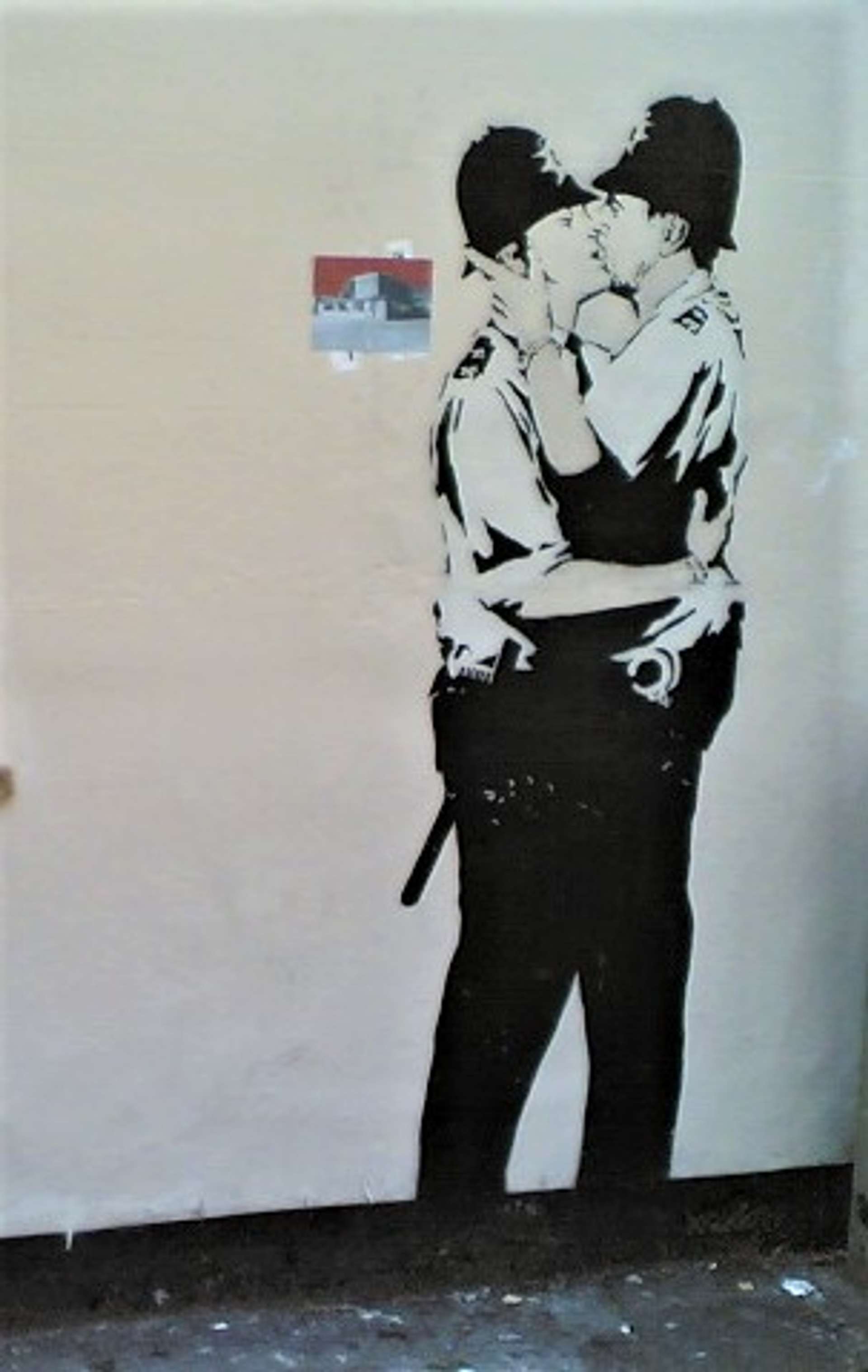 Image: ShoZu, CC 2.0, via Wikimedia Commons / Kissing Coppers © Banksy 2004
Image: ShoZu, CC 2.0, via Wikimedia Commons / Kissing Coppers © Banksy 2004Where are Banksy's Kissing Coppers now?
Controversially, the owner of the pub which Banksy spraypainted with Kissing Coppers sold the work at auction in 2014 for 575,000 US dollars. This decision left many people extremely upset, given that the work was initially seen as a gift to both Brighton's local LGBTQ community and to the broader community elsewhere.
What's the story with Banksy's Snorting Copper?
In 2005, a Banksy mural appeared on the outside of a public toilet in shoreditch, depicting a British police officer on the floor, a stance that at first glance could befit a snoop doing his job, searching for evidence, but which on closer examination reveals the cop in the process of sniffing cocaine.
Again, Banksy was making a point about alleged corruption in the police force, including the common allegation that while officers crack down particularly hard on drugs related offences, they are no strangers to the substances they confiscate...
While Banksy's beef with the police tends usually to involve a more general complaint about their use of force, or that they are complicit in the authoritarianism Banksy sees in the state, here, the drugs-related accusation helps him tap into a clichéd stereotype of the hypocritical copper, in order to undermine their authority.
Unsurprisingly, the council quickly painted over the mural, which was on their own property. The mural saw daylight again when a property developer, who had bought the land from the council, took the decision to painstakingly remove and restore the wall on which Banksy had painted. In 2017, despite the artwork being valued at £1.25 million, the developers chose to return the wall to its exact original location, with greater security—an admirable decision based in their belief that the artwork belonged to the public.
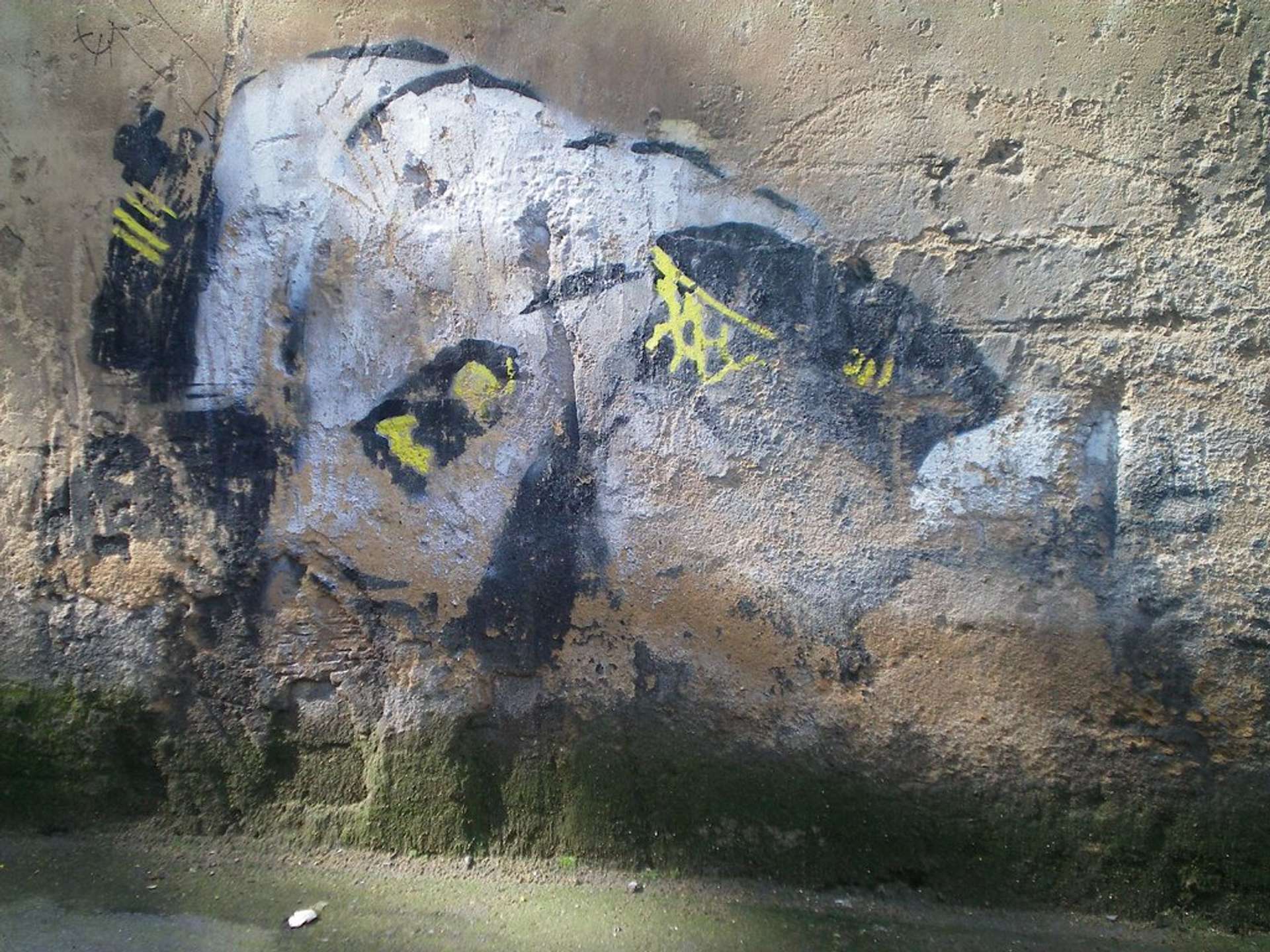 Image: eddiedangerous via Flickr CC 2.0 / Snorting Copper © Banksy 2005
Image: eddiedangerous via Flickr CC 2.0 / Snorting Copper © Banksy 2005Banksy's street art is still subject to the powers that be. His artwork on the streets is at the whim of private property owners, local council authorities, and, in theory, the police. But Banksy is no longer quite so much 'under the thumb' of authority, given the support of the public, the greed of property owners, and the shared awareness that removing or otherwise opposing Banksy's work would be vastly unpopular.
This leads many to question the extent to which Banksy's work has lost its edge when it comes to critiquing the police and subverting authority. While some would argue Banksy's work has lost the thrill of the illicit, you don't have to look far to see that this is not the case. Even very recently, the artist has proved his capacity to generate disorder and push the boundaries of legality, with his stunt at Sotheby's, which left people questioning the legitimacy of the sale, the authority of the well-respected auction house, and Banksy's unmatched ability to poke fun at power.
Last Updated: 14/09/2023





